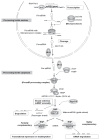MicroRNA let-7: an emerging next-generation cancer therapeutic
- PMID: 20179807
- PMCID: PMC2826782
- DOI: 10.3747/co.v17i1.356
MicroRNA let-7: an emerging next-generation cancer therapeutic
Abstract
In recent years, various RNA-based technologies have been under evaluation as potential next-generation cancer therapeutics. Micrornas (miRNAS), known to regulate the cell cycle and development, are deregulated in various cancers. Thus, they might serve as good targets or candidates in an exploration of anticancer therapeutics. One attractive candidate for this purpose is let-7 ("lethal-7"). Let-7 is underexpressed in various cancers, and restoration of its normal expression is found to inhibit cancer growth by targeting various oncogenes and inhibiting key regulators of several mitogenic pathways. In vivo, let-7 administration was found effective against mouse-model lung and breast cancers, and our computational prediction supports the possible effectiveness of let-7 in estrogen receptor (ER)-positive metastatic breast cancer. Data also suggest that let-7 regulates apoptosis and cancer stem cell (CSC) differentiation and can therefore be tested as a potential therapeutic in cancer treatment. However, the exact role of let-7 in cancer is not yet fully understood. There is a need to understand the causative molecular basis of let-7 alterations in cancer and to develop proper delivery systems before proceeding to therapeutic applications. This article attempts to highlight certain critical aspects of let-7's therapeutic potential in cancer.
Keywords: Let-7; cancer therapy; future medicine; let-7 regulation; microrna.
Figures



References
-
- Filipowicz W, Bhattacharyya SN, Sonenberg N. Mechanisms of post-transcriptional regulation by micrornas: are the answers in sight? Nat Rev Genet. 2008;9:102–14. - PubMed
-
- Zhao Y, Ransom JF, Li A, et al. Dysregulation of cardiogenesis, cardiac conduction, and cell cycle in mice lacking mirna-1–2. Cell. 2007;129:303–17. - PubMed
-
- Plaisance V, Abderrahmani A, Perret–Menoud V, Jacquemin P, Lemaigre F, Regazzi R. Microrna-9 controls the expression of Granuphilin/Slp4 and the secretory response of insulin-producing cells. J Biol Chem. 2006;281:26932–42. - PubMed
LinkOut - more resources
Full Text Sources
Other Literature Sources

